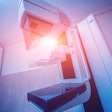Contrast-enhanced mammography (CEM) has utility as a surveillance tool for women with a personal history of breast cancer, according to research presented on 6 December at the San Antonio Breast Cancer Symposium.
In her talk, Julia Matheson from the University of Melbourne in Australia shared research indicating that CEM surveillance leads to increased detection of clinically significant breast lesions, as well as lower interval cancer rates.
“CEM increases the sensitivity of surveillance programs for women with a personal history of breast cancer,” Matheson said.
Annual mammography with or without supplemental ultrasound is the standard protocol for women with a personal history of breast cancer. These women have a higher rate of developing subsequent breast malignancies, including interval cancers.
Previous research has demonstrated that CEM is more sensitive than conventional mammography and is on par with MRI when it comes to specificity. However, Matheson said CEM’s use in surveillance imaging remains unknown.
The Matheson team studied CEM’s potential role in surveillance imaging, using retrospective data from 1,190 women with a personal history of breast cancer. CEM was the sole surveillance imaging modality used in the study, which included 3,782 episodes of surveillance.
The researchers found that CEM recalled 186 of these episodes for further assessment, a recall rate of 4.9%. Of these, 71 were true-positive cases, a cancer detection rate of 18.7 per 1,000 screens. Matheson said that 50 of these true positives were invasive cancers while the remaining 21 were ductal carcinoma in situ (DCIS) cases. Additionally, 48% of the true-positive cases were only recalled due to the contrast component of the imaging.
The team also found that 62% of lesions only identified due to the contrast component were invasive cancers, with most being grade 2 or 3. Triple-negative breast cancers made up another one-third of invasive cancers found through contrast use.
“An important consideration when introducing a more sensitive surveillance modality is the risk of overdiagnosis, but our results were reassuring,” Matheson said.
Surveillance-detected cancer rates differed by background parenchymal enhancement (BPE) and index cancer subtype, the researchers also reported. Matheson said that higher detected cancer rates were observed in women with moderate or marked BPE at the first CEM exam. Additionally, the team found that the highest detection rate was in women with index triple-negative breast cancer.
Finally, the team observed a low interval cancer rate in the study: 0.8 per 1,000 screens.
Matheson noted that CEM may be more accessible and preferred over breast MRI and could be a viable alternative for women who are unable to undergo MRI exams.



















